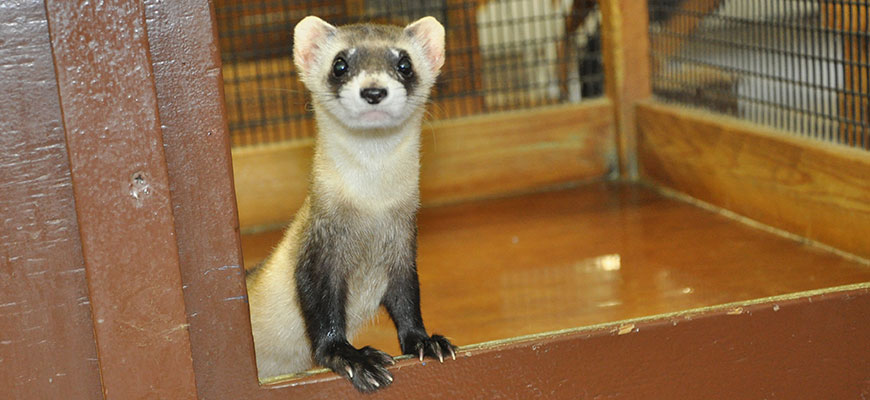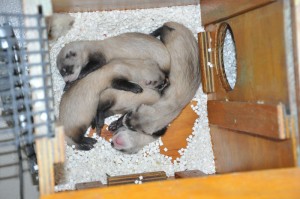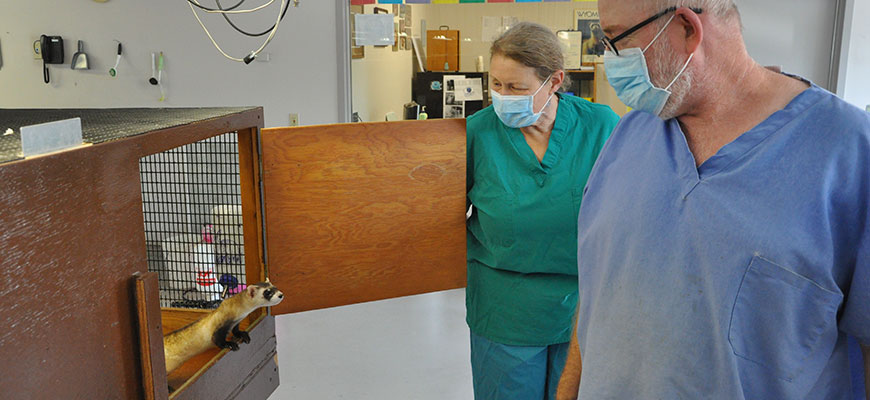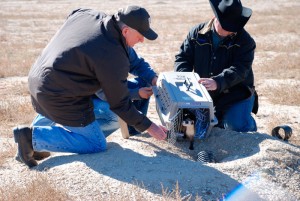by Joanne Luyster
The Louisville Zoo reached a millennial milestone this summer in its black-footed ferret recovery efforts. The 1,000th black-footed ferret kit to be born at the Zoo’s Conservation Center arrived June 10. The kit, named JoGuy in honor of longtime ferret keepers Guy Graves and Joanne Luyster, as well as black-footed ferret reproduction pioneer JoGayle Howard, was born to dam “Rhianna” and sire “Fettuccine.” The kit, along with its four littermates, spent the summer with “mom” growing and learning the ABC’s of black-footed ferret behavior.
To commemorate this occasion, the staffs of the Zoo’s Conservation Center and Animal Health Center hosted a celebration for Zoo staff, docents, and Zoo Foundation Board members. Attendees were able to tour the off-exhibit captive breeding facility and see the ferrets through a viewing window, which does not interfere with or disturb the ferrets. Afterwards, the celebrants enjoyed a picnic pizza lunch provided by Zoo director John Walczak and desserts courtesy of the Zoo’s American Association of Zoo Keepers chapter. In addition, the US Fish and Wildlife Service (USFWS) Black-Footed Ferret Recovery Implementation Team awarded certificates of appreciation to Guy and Joanne in recognition of their many contributions to black-footed ferret recovery.
Background
Considered one of the rarest mammals in North America, the black-footed ferret (BFF) is a solitary, nocturnal mustelid that populated the Great Plains from Canada to Mexico inhabiting the burrows of its primary prey, the prairie dog. Habitat destruction and government-sponsored poisoning of prairie dogs decimated the ferret population, once estimated at 500,000. The black-footed ferret was declared extinct in 1979, but a remnant population was discovered in Meeteetse, Wyoming in 1981. Biologists studied the ferrets, and when the population drastically declined in 1985 due to outbreaks of canine distemper virus and sylvatic plague, the last 18 black-footed ferrets were captured and placed in a captive breeding program.
Current captive breeding sites include USFWS’s Ferret Conservation Center in Colorado, which houses the majority of black-footed ferrets, as well as Louisville Zoo, Cheyenne Mountain Zoo, National Zoo’s Science and Conservation Breeding Institute, Phoenix Zoo, and Toronto Zoo. There are 21 reintroduction sites scattered across the North American Plains including Canada and Mexico. Approximately 300–400 wild black-footed ferrets now inhabit these reintroduction sites. The Walker Ranch, in Colorado, became the latest reintroduction site last fall, and 20 of the ferrets released there came from the Louisville Zoo, including several of dam “Sweet Tee’s” kits.
Louisville Zoo’s Involvement
The Louisville Zoo joined the recovery effort in 1991. A proud participant in the reestablishment of the black-footed ferret into its native Great Plains habitat, the Zoo’s Conservation Center has, to date, produced over 1,000 kits and provided over 650 ferrets for reintroduction. The Conservation Center’s success is due, in no small part, to the dedication of keeper Guy Graves, who has been with our program from the beginning. Guy’s long term involvement has allowed him to gain a keen insight into the habits and behaviors of the ferrets under his care, and with this knowledge Guy has made numerous contributions to the program. Other facilities often rely on Guy to share his expertise as well as help them solve new issues or problems that develop.
LZ Reintroduction Site Involvement.
Today, few opportunities exist for someone to observe and interact with an endangered species in its natural habitat. However, ferret keeper Angie Cox and I were able to do just that! Twice, Angie and I have traveled to Kansas to participate in the survey efforts at the black-footed ferret reintroduction site in Logan County, which is comprised of the privately owned Haverfield/Barnhardt/Blank ranch and The Nature Conservancy’s Smoky Valley Ranch. Conservation biologists team up with volunteers such as Angie and myself to assess and monitor the status of the reintroduced population of endangered black-footed ferrets, including locating and counting as many first-year kits as possible.
A survey crew consists of a high-clearance vehicle occupied by two or more surveyors who are outfitted with spotlights, GPS units, communications radios, maps and data sheets. Surveys take place from sundown to sunrise, weather permitting, and are scheduled around a full moon. The crew drives randomly-spaced routes around a pasture using spotlights to search for the signature emerald green eye-shine of ferrets. Other animals are out and about at night, and many a surveyor has been disappointed to find that the eye-shine they thought was a ferret was really a swift fox!
During the fall survey, each ferret that is observed entering a specific burrow is captured for identification. A live trap is placed on the burrow and checked frequently (at least every hour) during the remainder of the night. Surveyors take a GPS reading of the location and place a reflector stake at the burrow to aid in relocating the site.
Once a ferret is captured, it is transported immediately to a central processing site nearby where it is anesthetized, given a veterinary exam, vaccinated against canine distemper virus, implanted with a transponder chip, if it does not already have one, and a temporary dye mark on the throat. (The dye mark insures that surveyors won’t trap the same ferret again.) After recovery from processing, the ferret is returned to the same burrow where it was trapped.
Participating in reintroduction surveys lets me “come full circle.” I began my career at the Louisville Zoo working with the black-footed ferrets in the Conservation Center, and I have stayed involved in the program whether it is in captive breeding efforts, driving ferrets out west for preconditioning, contributing to the black-footed ferret husbandry manual or spotlighting ferrets in Kansas. This involvement has allowed me to play a rare part in an important conservation effort to save an endangered species.
Originally published in Trunkline Magazine, Sept. 2014.




